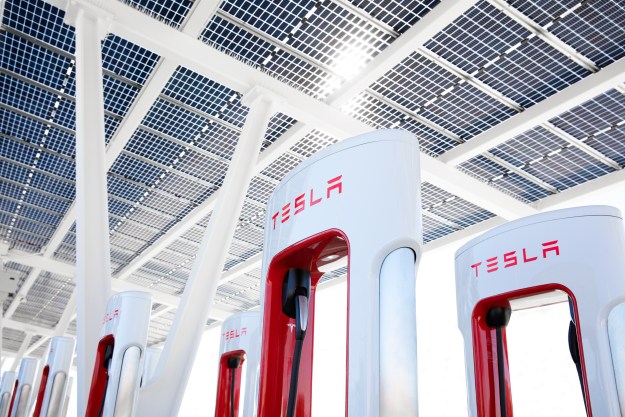Tesla opened its first Supercharger in California in 2012. Today it has 10,000 of them at more than 1,200 stations around the world. Elon Musk’s electric-car company tweeted news of its milestone 10,000th Supercharger over the weekend. It opened in Belleville, Ontario, about 100 miles east of Toronto.
Expansion has been rapid in recent years. In 2013, most Superchargers were located in California and on the busy East Coast route between Boston and Washington, D.C. In early 2014, new stations made it possible for the first time to complete a coast-to-coast route, and since then Tesla has worked to build Supercharger stations in nearly all U.S. states, with only North Dakota, Alaska, and Hawaii currently without one.
Tesla’s 10000th Supercharger is now open in Belleville, Ontario: https://t.co/lqJMwRaxxH pic.twitter.com/E4iY4vfAiH
— Tesla (@Tesla) June 9, 2018
As its name cleverly suggests, the Supercharger can replenish a Tesla car’s battery in ultra-quick time compared to regular charging systems. For example, in just 30 minutes, a Supercharger can give a Tesla Model S 170 miles of driving range. Or stick around for 75 minutes and you’ll have yourself a fully charged battery for an even longer drive.
Superchargers are free to use for Model S and Model X owners, often via a referral code. Owners of the more affordable Model 3, meanwhile, have to pay to recharge the vehicle’s battery, with the cost dependent upon local electricity rates.
The company is also starting to build larger charging stations that include facilities that people can enjoy while their vehicle charges. Aimed primarily at those embarking on long-distance trips, most are being placed in small communities along busy highways that connect major cities. One such facility opened in Kettleman City, California, last November, and features a building with a large lounge area and a cafe, as well as a space that showcases Tesla Energy products such as its solar panels and Powerwall battery packs.
If you’re interested to explore the kinds of routes you can currently take via Tesla’s growing network of charging stations, check out its online tool that plots the most efficient path between two locations. Alternatively, check out Tesla’s map of all of its charging facilities around the world.
Tesla says on its website that it’s continuing efforts to build new charging sites “to enable additional routes and expand popular stations,” so expect plenty more in the coming years.
Editors' Recommendations
- Tesla to begin production on new, more affordable models
- Here’s how Ford will give EV customers Tesla Supercharger access
- Tesla Roadster: speed, range, price, rumored release date, and more
- Tesla’s Optimus humanoid robot can now dance like Elon Musk
- Honda recalls more than 300,000 vehicles over seat belt safety issue


